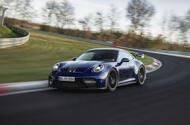Porsche 911 GT3 Sets New Record: What It Means for Car Enthusiasts
The automotive world is buzzing with excitement following the recent announcement that the Porsche 911 GT3 has claimed the title of the fastest manual car to lap the Nürburgring. This achievement not only highlights Porsche’s engineering prowess but also speaks volumes about the enduring appeal of manual transmissions in high-performance vehicles.
The New Record: A Closer Look at the Numbers
In a stunning display of speed and precision, the latest iteration of the 911 GT3, known as the ‘992.2,’ completed the iconic Nordschleife circuit in an impressive 6 minutes and 56.294 seconds. This time eclipses the previous record held by the Dodge Viper ACR by nearly 10 seconds, a remarkable feat considering the Viper’s powerful 8.4-liter V10 engine, which produces 645bhp.
To put this into perspective, the Viper’s record lap time of 7 minutes and 1.3 seconds was achieved on a shorter version of the track in 2017, translating to approximately 7 minutes and 5.8 seconds on the full 20.832-kilometer circuit. Thus, the GT3’s manual transmission variant outpaced the Viper by a significant margin of 9.5 seconds, showcasing the remarkable capabilities of Porsche’s engineering team.
The Car Behind the Record: Features and Specifications
The record-setting GT3 was equipped with the Weissach Package, a £20,000 optional upgrade that incorporates weight-saving measures, reducing the car’s weight by 12 kilograms. This lightweight design, combined with Michelin Pilot Sport Cup2 R tires, which are road-legal yet designed for maximum grip, contributed to the GT3’s exceptional performance on the track.
Andreas Preuninger, head of Porsche’s GT division, emphasized the growing preference for manual transmissions among GT3 customers. He noted that while the PDK automatic variant is faster, the manual version’s record lap time answers a pressing question for enthusiasts: just how fast can a manual GT3 go on the Nordschleife?
The Appeal of Manual Transmissions: A Nostalgic Connection
Despite the rise of automatic transmissions, particularly dual-clutch systems that offer lightning-fast gear changes, the allure of manual gearboxes remains strong among car enthusiasts. According to Porsche, nearly a quarter of standard GT3s sold in the UK are equipped with a manual transmission, and this figure rises to over half for the wingless GT3 Touring models.
This trend reflects a broader sentiment in the automotive community: many drivers cherish the tactile engagement and control that a manual transmission provides. The connection between driver and machine is often cited as a key reason for choosing a manual, making the recent record even more significant for those who appreciate the art of driving.
What This Means for the Future of Performance Cars
The Porsche 911 GT3’s achievement at the Nürburgring is not just a milestone for the brand; it signals a potential resurgence in the popularity of manual transmissions in high-performance vehicles. As manufacturers continue to innovate and push boundaries, the question remains: will we see more brands embracing the manual gearbox in their performance models?
The record also serves as a reminder of the importance of driver engagement in an era increasingly dominated by automation and electric vehicles. As the automotive landscape evolves, the desire for a visceral driving experience may lead to a renewed interest in manual transmissions, particularly among purists who value the skill and connection they offer.
In summary, the Porsche 911 GT3’s record lap at the Nürburgring is a testament to the brand’s commitment to performance and driver engagement. As the automotive industry continues to innovate, this achievement may inspire a new generation of enthusiasts to appreciate the thrill of driving a manual transmission, ensuring that the art of driving remains alive and well.

